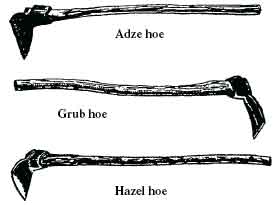Tool Talk 2: Grubbing

May 11, 2021

Your gift by 12/31 will be matched! Double your impact, and be entered for a chance to win new gear prize packages. →

May 11, 2021

Welcome to the second edition of Tool Talk! This edition will be covering the tools typically used in trail work for “grubbing”.
Grubbing is a term used to describe the process of digging in the dirt. Trail workers “grub” for a variety of reasons. They may be removing unwanted material from drains, for example, by digging out vegetative material left by flowing water, or they may grub to build a new section of sidehill trail by removing a good deal of vegetation and top soil, before digging into and creating a “bench” of mineral soil that will host the footpath.
Whether you are constructing a new trail or maintaining an existing one, these grubbing tools are great for getting the job done:
Fire Rake
The fire rake is frequently used as a wildland firefighting tool, but it is also commonly used in trail work – especially on the east coast. The sharp teeth of the fire rake allow for it to cut through vegetative top soils. This action tends to allow for the fire rake to cut deeper into the earth than an average household rake that is best used for moving surface debris.

Hoes
Hoes (adze, grub, or hazel) are great at breaking up sod clumps when either constructing new trail or when leveling existing trail tread. They are also a great tool for clearing out drainage structures. Many volunteers find them easier to carry and effective for most grubbing tasks.

Mattocks
With various applications, mattocks are usually the first-choice tool for any trail worker, especially the quintessential trail work tool, the pick mattock. The pick side of a pick mattock can be used for prying/moving rocks and breaking up hard/compacted soil, while the grubbing side is perfect for moving softer or looser material and finishing up tread definition. Pick mattocks usually come standard with a 5lb head, but for lighter tasks volunteers can take advantage of the lighter 2.5lb version. A cutter mattock on the other hand has a cutter side rather than a pick side. The cutter side is perfect for chopping away at inground roots.

McLeod
The McLeod is a combination of a heavy-duty rake and a large sturdy hoe. They work best in light soils, such as for reestablishing the tread of the trail after material from the backslope has sloughed onto it.

Pulaski
The Pulaski is considered a multipurpose firefighting tool. Its versatile nature also makes it a great tool for trail work. It combines a grubbing side for clearing the surrounding dirt away, with an axe side, which cuts in–ground roots exposed after grubbing. The Pulaski is a versatile tool. Some trail workers prefer one Pulaski rather than multiple single use grubbing tools, making it a popular tool for trail work.

Appalachian Trail Fieldbook is a great hip-pocket guide to trail care. The Fieldbook highlights that well-designed sections of Trail without significant erosive tendencies will have leaf litter present and won’t have loose rocks or roots as a result.
Tool handling best practices for keeping safety in mind are found in the Hand Tools Job Hazard Analysis reference resource.

Your gift by 12/31 will be matched by a group of generous donors! Plus, you’ll be entered into our New Year Gear giveaway. Double your impact, and get a chance to win big.
Give Now